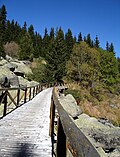Biosphere reserve
A biosphere reserve is an ecosystem with plants and animals of unusual scientific and natural interest. It is a label given by the UNESCO to help protect the sites.[1] The plan is to promote management, research and education in ecosystem conservation. This includes the 'sustainable use of natural resources'. If, for example, fish or trees are taken for human use, this is done in ways which least damage the ecosystem.
A biosphere reserve consists of three zones:
- i) Core zone: No human activity is permitted in this zone.
- ii) Buffer zone: It surrounds the core area, where a limited access permits to local people for the gathering of resources.
- iii) Free zones: It is the outermost zone, which is open to human settlements and resource gathering.
The program is run by UNESCO's Man and the Biosphere Program. It has started a World Network of Biosphere Reserves. The MAB program has built up the World Network of Biosphere Reserves since 1971. Biosphere reserves, exchange knowledge and experiences on new ideas for sustainable development. They are areas used to develop new ways of doing things, test these ways and share the results. The objective is to get a balanced relationship between mankind and nature.[1] The biosphere is very important to humans.
Biosphere Reserve Media
Bee Lick Creek in the Jefferson Memorial Forest, a National Audubon Society wildlife refuge
Charles Waterton established the first nature reserve in 1821.
A forest of the Aulanko Reserve in Hämeenlinna, Tavastia Proper, Finland
A bridged stone river in Bistrishko Branishte, an early Bulgarian nature reserve established in 1934
Nature reserve near Budapest, next to Lake Naplás
Bjeshkët e Nemuna National Park, one of two national parks in Kosovo
Path on Szczeliniec Wielki, a famous nature reserve in the Stołowe Mountains in SW Poland
Dena, a biosphere reserve in Iran
References
- ↑ 1.0 1.1 UNESCO Biosphere Reserves, retrieved 1 July 2011










